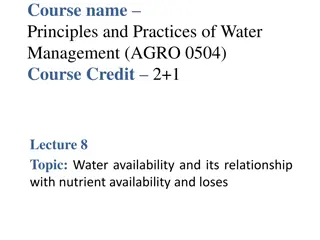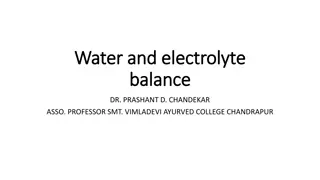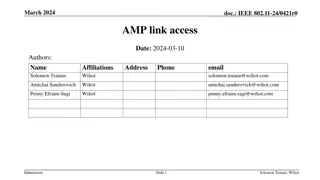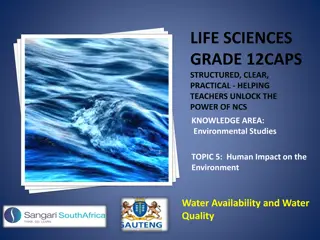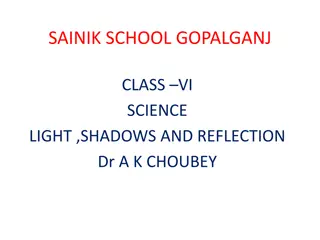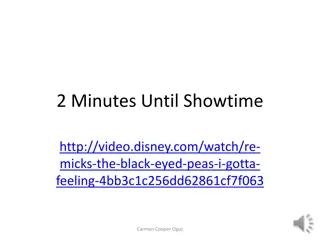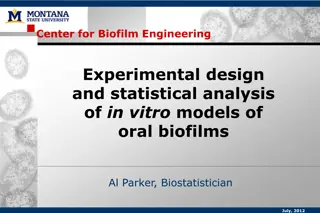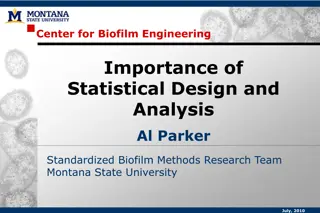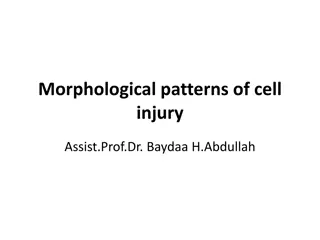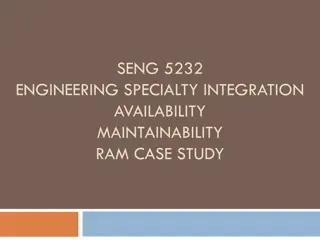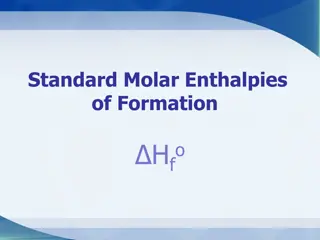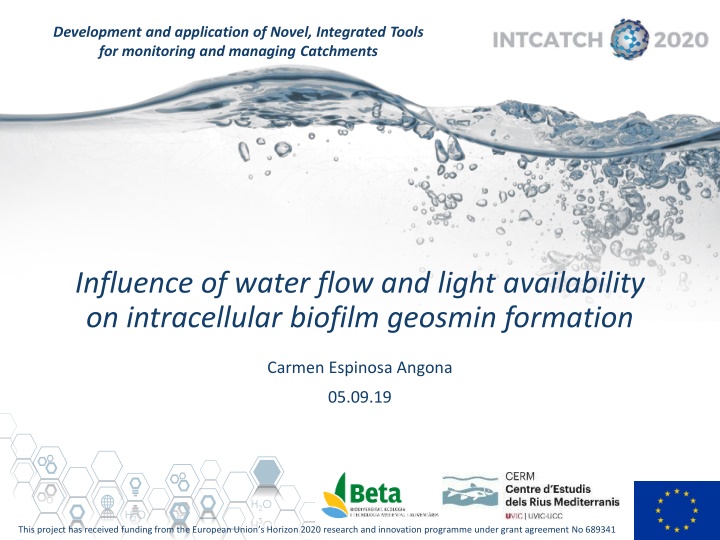
Novel Integrated Tools for Catchment Monitoring and Management
This project explores the impact of water flow and light availability on the formation of geosmin-producing organisms in biofilms within catchments. The study aims to evaluate the relationship between light irradiation, water flow, and geosmin production, offering insights for better catchment management strategies.
Download Presentation

Please find below an Image/Link to download the presentation.
The content on the website is provided AS IS for your information and personal use only. It may not be sold, licensed, or shared on other websites without obtaining consent from the author. If you encounter any issues during the download, it is possible that the publisher has removed the file from their server.
You are allowed to download the files provided on this website for personal or commercial use, subject to the condition that they are used lawfully. All files are the property of their respective owners.
The content on the website is provided AS IS for your information and personal use only. It may not be sold, licensed, or shared on other websites without obtaining consent from the author.
E N D
Presentation Transcript
Development and application of Novel, Integrated Tools for monitoring and managing Catchments Influence of water flow and light availability on intracellular biofilm geosmin formation Carmen Espinosa Angona 05.09.19 H2O H2O This project has received funding from the European Union s Horizon 2020 research and innovation programme under grant agreement No 689341
Development and application of Novel, Integrated Tools for monitoring and managing Catchments Introduction Ter River Ter River H2O Problems: Highly regulated by weirs, leaving reaches with low flows and without natural substrate. Intensive agriculture and livestock Urbanization. H2O 2
Development and application of Novel, Integrated Tools for monitoring and managing Catchments Introduction What is geosmin? Metabolite actinomycetes. It generates bad taste and smell of water. produced by cyanobacteria and 5 10 ng/L H2O H2O 3
Development and application of Novel, Integrated Tools for monitoring and managing Catchments Introduction Biofilm The biofilm is a consortium of phototrophic and heterotrophic microorganisms embedded in a mucilage matrix. SUBSTRATUM H2O Mucopolysaccharide Extracellular enzyme Alga Cyanobacterium Fungi Protozoa Bacterium Oscillatoria spp. Anabaena spp. Giglio et al., 2008 H2O Temperature Vilalta et al., 2003 Water flow Sabater et al., 2014 Nutrient availability Stelzer et al., 2001 4
Development and application of Novel, Integrated Tools for monitoring and managing Catchments Objective To evaluate the effect of light irradiation and water flow in the appearance of geosmin- producing organisms. H2O H2O 5
Development and application of Novel, Integrated Tools for monitoring and managing Catchments Experimental design H2O H2O 6
Development and application of Novel, Integrated Tools for monitoring and managing Catchments Experimental design 20% Irradiation (LL) 100% Irradiation (HL) March April 2018 (41days, 7 samplings) F1= 0.09 L/s F2= 0.18 L/s F3= 0.36 L/s F4= 0.72 L/s F5= 1.10 L/s H2O LL HL H2O 10 treatments 7
Development and application of Novel, Integrated Tools for monitoring and managing Catchments Experimental design Parameters evaluated: Physicochemical: pH, EC, Temp., DO, % saturation Nutrients, SS, Turbidity Irradiation and T in continuous (HOBO) Biological H2O Water sample OM Biofilm sample Geosmin, Chl a , AFDM, photosynthetic efficiency, and characterization of communities H2O 8
Development and application of Novel, Integrated Tools for monitoring and managing Catchments Results Physicochemical parameters n = 84 Mean SD 8.4 0.2 9 3 344 54 11.3 0.9 99 7 0.08 0.06 0.007 0.005 0.9 0.3 0.03 0.05 Min. 7.92 7 260 7.8 72 0.03 0.001 0.5 0.001 Max. 8.72 16 440 12.9 113 0.29 0.017 1.5 0.16 pH Water temperature( C) EC ( S/cm) DO (mg/L) Saturation (%) N-NH4+ (mg/L) N-NO2-(mg/L) N-NO3-(mg/L) P-PO43-(mg/L) H2O H2O 9
Development and application of Novel, Integrated Tools for monitoring and managing Catchments Results Biofilm attributes H2O H2O 10
Development and application of Novel, Integrated Tools for monitoring and managing Catchments Results Nutrient uptake rate H2O N:P ~ 400 H2O N:P ~ 14 11
Development and application of Novel, Integrated Tools for monitoring and managing Catchments Results Community composition The parameters light and water flow generate differences in the communities of each flumes. 100% Scenedesmus sp. Gomontiella sp. Fragilaria sp. Cymatopleura sp. Hantzschia sp. Pinnularia sp. Surirella sp. Gyrosigma sp. Achnantes sp. Navicula sp. Coconeis sp. Gomphonema sp. Nitzschia sp. Cymbella sp. Melosira sp. Oscillatoria sp. 90% 80% 70% The genera Oscillatoria sp. is affected for the interaction of light and water flow (p < 0.001), being higher in the flume with lower water flow and low light (F1LL). Biovolume (%) 60% Flume x Oscillatoria sp. P < 0.0001 Melosira sp. P < 0.05 Pinnularia sp. P < 0.05 H2O 50% 40% 30% 20% 10% 0% V1 HL V2 HL V3 HL V4 HL V5 HL V1 LL V2 LL V3 LL V4 LL V5 LL H2O + - 12
Development and application of Novel, Integrated Tools for monitoring and managing Catchments Results Geosmin concentration Geosmin LL HL (24.5%) 3000 Geosmin concentration (ng/g) 2500 2000 1500 H2O 1000 500 0 F1 F2 F3 F4 F5 Treatment The geosmin concentrationis correlated with: H2O - - - - Oscillatoria sp. (p < 0.0001) AFDM (p < 0,01) AI (p < 0,01) MI (p < 0.01) (47.4%) 13
Development and application of Novel, Integrated Tools for monitoring and managing Catchments Results Geosmin concentration Geosmin (38.4%) LL HL 3000 Geosmin concentration (ng/g) 2500 2000 1500 H2O 1000 500 0 F1 F2 F3 F4 F5 Treatment H2O The geosmin concentration is correlated with: - - Temp (p < 0.05) Phosphate (p < 0.001) (44.9%) 14
Development and application of Novel, Integrated Tools for monitoring and managing Catchments Conclusions Both parameters (light and water flow) influence un the biofilm structure- function. Low water flow (0.09 0.18 L/s) and low light irradiance (20%) favours: Highest Oscillatoria sp. abundance Lower Chl-a concentration Aged and accumulated accessory pigments Higher AI H2O Different communities showed differences in nutrient uptake efficiencies F1LL lower phosphate uptake N: P ratio lower (14) The interaction between low light and low water velocity (F1LL) favours the geosmin formation in the biofilm. H2O 15
Development and application of Novel, Integrated Tools for monitoring and managing Catchments Thank you for your attention Carmen Espinosa Angona carmen.espinosa@uvic.cat H2O H2O This project has received funding from the European Union s Horizon 2020 research and innovation programme under grant agreement No 689341




